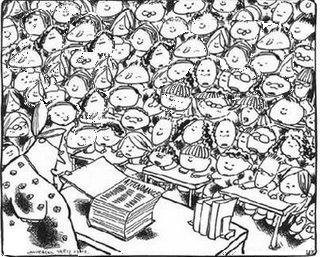The Dynamics of Class Size and Achievement in Education

Introduction
With the low amount of qualified teachers available in the U.S., a simple solution would be to increase the class size (the number of students in the classroom). However, before adopting such an option wholeheartedly, it is of interest to know the dynamics of class size in relation to academic achievement. It is dubious that increasing the size of a class would not affect achievement in any way. In fact, many states have put laws in place in order to limit the class size in grades k-12. California, like most other states, has its maximum class size around 30, believing that this cutoff is necessary to prevent class size from affecting educational achievement (California Department of Education, 2013). Since laws have been put in place to ensure class size does not disrupt the purpose of education, there should be an emphasis placed upon research on the dynamics of class size and achievement in order to help adjust laws to the actual nature of education. Therefore, the questions of why, when, and how exactly does class size effect educational attainment, along with the question of who does class size effect, need to be addressed.

Why Does Class Size Hurt Achievement?
A problem with increasing class size is that “Class size effects the amount of time that teachers devote to controlling students behavior” (Hallinan and Sorenson, 1985). With a larger class, comes more disciplinary duties. This distracts the teacher from instructing the students; thus, reducing the amount of knowledge conveyed to the students, which in turn could possibly reduce student achievement. Nonetheless, more discipline does not always negatively affect achievement. A meta-analysis found this to be true and argues that, “by itself,” time spent on discipline is unrelated to student achievement (Ehrenberg et al., 2001). Discipline only significantly affects achievement in some cases. Consequently, some moderating variable must affect the relationship between the time spent on discipline and achievement. Increasing the size of a class may affect the time spent on discipline, but the time spent on discipline only hurts achievement under certain circumstances.
Another problem facing the increase of class size is that it would increase the amount of work a teacher must put forth in organizational tasks and grading. Squeezing out more work from teachers may hurt their ability to offer a quality education. Teaching is commonly believed to be more difficult, the more students there are. (Hallinan and Sorenson, 1985). As a result, teachers may view their jobs as becoming more difficult when their class sizes increase. The Thomas theorem argues that if something is perceived as real, it is real in its consequences. Therefore, if a teacher believes his or her job is more difficult, the teacher is likely to react in a self-fulfilling prophecy, in which the teacher would not try as much to offer quality teaching because the teacher views teaching so many students as too difficult. Thus, increasing class size could have an adverse effect on student achievement as a result of the reduced teacher quality.
A plethora of problems for student achievement could come from increasing class size because, in smaller classes, pupils spend more time on-task, more curriculum is covered, more time and space are available, there is better morale, teachers can use individualization more often and there is better pupil-pupil relations (Blatchford and Mortimore, 1994). In a smaller class, students and the teacher can all bond together more easily, whereas in an oversized class it is difficult to get to know everyone. A larger class hurts student morale and relations, which could hurt their motivation to learn and achieve in the classroom. Also, increasing the size of a class would reduce resources, whether they be physical or instructional. A teacher’s ability to use individualization, a method of relating teaching to the individual student’s needs, would be more constrained in a larger class because there are more students the teacher must teach. Students’ needs cannot be met as well in a larger class, which means that class size does affect achievement.
When Does Class Size Hurt Achievement?
A meta-analysis was constructed in order to answer the question of ‘at what point does class size significantly hurt achievement’? The results indicated that, in the well-controlled studies examined, there is a strong negative correlation between class size and achievement. However, this correlation becomes insignificant at about 20 students; this means that increasing class size does not really hurt academic achievement in classes with at least 20 students (Glass and Smith, 1979). To be more specific, the results indicated that a class size of 20 is at the 58th percentile rank in achievement, whereas a size of ten is at the 66th and a class size of one is at the 83rd. This would mean that class size would have to be dramatically reduced from today’s standard of about 30 to have any worthwhile positive effect on achievement.
On the other hand, the meta-analysis may not be reliable. There is a great amount of inconsistency in class size and achievement across different schools. “School context interacts with small class effects”; so, only in the context of some schools does a small class size actually help student achievement (Konstantopoulos, 2011). Since meta-analyses examine so many different studies, they also examine several different schools, making them unreliable. The cutoff at which class size significantly affects academic achievement varies by context. Thus, it is necessary to examine the context. More specifically, who does class size affect?

Who is Hurt by Class Size?
Class size can hurt the achievement of some classes more drastically than others. For example, a study found that, with regards to statistics courses, class size does not affect the level of achievement. Three college-level classes of about 39 students had their grade distributions compared to three classes of about 118 students. The grade distributions were similar among all cases, showing that class size did not affect achievement. Statistics courses do not similarly react to an increase in class size, revealing that “treating all courses the same may be one of the most expensive and most common mistakes in higher education” (Hancock, 1996). Math is concrete, so it cannot as easily be tailored to every student’s individual needs or discussed about in an open fashion amongst peers as other subjects can be such as English, philosophy, or psychology. Therefore, the more concrete a subject is, the more unlikely that class size affects achievement.
Disadvantaged students and students in their early education years (grades k-3) are the most negatively affected groups by an increase in class size (Blatchford and Mortimore, 1994). Early in their education, students need a more personal approach and more discipline in order to be socialized within the institution of education. In grades k-3 students need more hands-on learning, so having a larger class would disrupt the teacher’s ability to meet individual students’ needs. It does make sense that students early in their education would suffer the most from a larger class size because early learning is the most critical. Additionally, disadvantaged students are hurt most by an increase in class size. Disadvantaged students are known as minority students or students with low SES. This could be because there is a “disproportionate number” of disadvantaged students in classes with more students (Hallinan and Sorenson, 1985). Because more disadvantaged students go in the classes with more students, the disadvantaged students’ academic achievement is most negatively affected by an increase in class size. Thus, the impact of class size is strongest on the achievement of disadvantaged students and students in grades k-3.
How Does Class Size Hurt Achievement?
As just noted, students in their early education years are most negatively impacted by an increase in class size. This is because of the teaching styles adopted by teachers in grades k-3, as opposed to teachers in the higher grades. Teachers in early grade school are “especially likely to use small groups, hands-on projects, and rely on personal relationships with students,” whereas teachers for older students largely rely on “whole-group lecture[s]” (Ehrenberg et al., 2001). These whole-group lectures can be applied to any number of students and do not reap the benefits of having smaller classes, unlike the individually tailored teaching style of teachers in early grade school do. In other words, an increase in class size does not significantly affect classes taught with whole-group lectures; on the other hand, it does affect a more personal type of teaching style.
If teachers have their class size changed, they do not typically respond by changing instructional methods in order to adapt to a different class size (Ehrenberg et al., 2001). Therefore, it would be largely fruitless to reduce class sizes if the teachers do not adopt the personal teaching approach. However, if teachers teach the class as if it was a whole and do not use individually tailored methods, then increasing the class size could save many resources. Overall, teachers must learn to adapt for smaller classes in order to maximize their students’ achievement, or teachers must take in more students in order to maximize resources.
Probable Solutions to the Class Size/Achievement Problem
A major problem is that teachers cannot adapt teaching styles properly to the number of student’s they have. Teachers need to orient teaching methods to the size of their class instead of simply offering one blanket strategy. A one-size-fits-all teaching method does not seem to work. Teachers need to especially learn to “exploit the opportunities of small groups” through a review of their teaching methods, training, and classroom management (Blatchford and Mortimore, 1994). If teachers are made aware of the personal teaching style to apply on students in small classes and the benefits that come from it, they will likely adapt.
Another problem that was previously addressed is that students in their early years of education and disadvantaged students are most negatively affected by an increase in class size. A simple solution would be to decrease the allowable maximum class size in early grade school and allow larger class sizes in higher grades. Higher grades would not suffer nearly as much from larger class sizes; consequently, if class sizes need to be increased due to lack of resources, cutting corners for lower grades should be avoided as much as possible. And, in order to solve the problem that class size has on disadvantaged students, it would be wise to avoid putting a disproportionate amount of disadvantaged students in classes with large amounts of students. Perhaps schools should be required to put the same amount of disadvantaged students in small classes as they do in large classes.
Lastly, large classes have added on responsibilities for teachers such as more disciplinary, organizational, and grading tasks that could hurt the academic achievement of the students. To solve this problem, a teacher’s aide could be added to classes with many students. Sometimes the resources just do not exist and there are not enough qualified teachers to have only small-sized classes. When classes need to be increased, a teacher’s aide, who does not need to be as qualified as the teacher, can be added to those classes to help with disciplinary, organizational, and grading tasks to offset the additional responsibilities expected from the teacher.
Conclusion
Class size has been found to affect achievement, except only in some cases. Class size may always affect discipline, but only in some circumstances has an increased need for discipline decreased student achievement. Likewise, there is a great amount of inconsistency in relation to class size and achievement with regards to school context. It must also be noted that students early in their education are most noticeably negatively affected by an increase in class size. The moderating variable for these discrepancies is likely the teaching style. A personal teaching style helps increase achievement for small class sizes, whereas a whole-group lecture teaching style does not. The moderating variable of teaching style could be accountable for these discrepancies. Firstly, the moderating variable helps explain the inconsistent effects of an increased need for discipline on achievement. An increased need for discipline would not be as detrimental to achievement in a whole-group lecture type of class as it would in a class taught under a personal teaching style on students’ achievement. Secondly, the accepted teaching style may also vary by school, which would explain the inconsistency of the negative effects on achievement from increasing class sizes across schools. Lastly, the teaching style mostly used by teachers in the early grade school years is the personal one, which would explain why an increase in class size would disproportionately affect students’ achievement levels in early grade school. In conclusion, the moderating variable of teaching style helps account for the inconsistent data found on the effect of class size on achievement; a personal teaching style can only be disrupted from an increase in class size because it is the teaching style that significantly increases students’ achievement and it requires a small class to function at its best.
Sources
Blatchford, P. & Mortimore, P. (1994). The Issue of Class Size for Young Children in Schools: What Can We Learn from Research? Oxford Review of Education, 20(4), 411-428.
California Department of Education (2013). Class Size Penalties. Sacramento, California:
CalEdFacts. Retrieved from http://www.cde.ca.gov/fg/aa/pa/cefcsp.asp
Ehrenberg, R. G., Brewer, D. J., Gamoran, A., & Wilms, J. D. (2001). Class Size and Student Achievement. Psychological Science in the Public Interest, 2(1), 1-30.
Glass, G. V & Smith, H. L. (1979). Meta-Analysis of the Relationship between Class-Size and Achievement. Educational Evaluation and Policy Studies, 1, 2-16.
Hallinan, M. & Sørensen, A. (1985). Class Size, Ability Group Size, and Student Achievement. American Journal of Education, 94(1), 71-89.
Hancock, T. M. (1996). Effects of Class Size on College Student Achievement. College Student Journal, 30(4), 479.
Konstantopoulos, S. (2011). How Consistent Are Class Size Effects? Evaluation Review,
35(1) 71-92.








